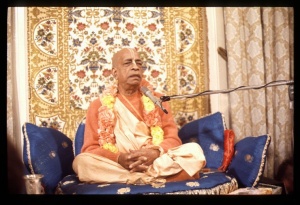CC Madhya 20.363: Difference between revisions
m (1 revision(s)) |
No edit summary |
||
| Line 1: | Line 1: | ||
{{ | [[Category:Sri Caitanya-caritamrta - Madhya-lila Chapter 20|C363]] | ||
<div style="float:left">'''[[Sri Caitanya-caritamrta|Śrī Caitanya-caritāmṛta]] - [[CC Madhya|Madhya-līlā]] - [[CC Madhya 20|Chapter 20: Lord Śrī Caitanya Mahāprabhu Instructs Sanātana Gosvāmī in the Science of the Absolute Truth]]'''</div> | |||
<div style="float:right">[[File:Go-previous.png|link=CC Madhya 20.362|Madhya-līlā 20.362]] '''[[CC Madhya 20.362|Madhya-līlā 20.362]] - [[CC Madhya 20.364|Madhya-līlā 20.364]]''' [[File:Go-next.png|link=CC Madhya 20.364|Madhya-līlā 20.364]]</div> | |||
{{CompareVersions|CC|Madhya 20.363|CC 1975|CC 1996}} | |||
{{RandomImage}} | |||
==== TEXT 363 ==== | ==== TEXT 363 ==== | ||
<div | <div class="verse"> | ||
avatāra-kāle haya jagate gocara | :avatāra-kāle haya jagate gocara | ||
ei dui lakṣaṇe keha jānaye īśvara“ | :ei dui lakṣaṇe keha jānaye īśvara“ | ||
</div> | </div> | ||
| Line 12: | Line 16: | ||
==== SYNONYMS ==== | ==== SYNONYMS ==== | ||
<div | <div class="synonyms"> | ||
avatāra- | ''avatāra-kāle''—at the time of incarnation; ''haya''—there is; ''jagate''—in the world; ''gocara''—information; ''ei dui lakṣaṇe''—by these two characteristics, namely ''svarūpa'' and ''taṭastha''; ''keha''—some persons; ''jānaye''—know; ''īśvara''—the incarnation of the Supreme Lord. | ||
</div> | </div> | ||
| Line 19: | Line 23: | ||
==== TRANSLATION ==== | ==== TRANSLATION ==== | ||
<div | <div class="translation"> | ||
“At the time of Their appearance, the incarnations of the Lord are known in the world because people can consult the śāstras to understand an incarnation’s chief characteristics, known as svarūpa and taṭastha. In this way the incarnations become known to great saintly persons.” | “At the time of Their appearance, the incarnations of the Lord are known in the world because people can consult the śāstras to understand an incarnation’s chief characteristics, known as svarūpa and taṭastha. In this way the incarnations become known to great saintly persons.” | ||
</div> | </div> | ||
__NOTOC__ | |||
<div style="float:right; clear:both;">[[File:Go-previous.png|link=CC Madhya 20.362|Madhya-līlā 20.362]] '''[[CC Madhya 20.362|Madhya-līlā 20.362]] - [[CC Madhya 20.364|Madhya-līlā 20.364]]''' [[File:Go-next.png|link=CC Madhya 20.364|Madhya-līlā 20.364]]</div> | |||
__NOTOC__ | |||
__NOEDITSECTION__ | |||
Revision as of 02:46, 8 September 2021
Śrī Caitanya-caritāmṛta - Madhya-līlā - Chapter 20: Lord Śrī Caitanya Mahāprabhu Instructs Sanātana Gosvāmī in the Science of the Absolute Truth

His Divine Grace
A.C. Bhaktivedanta Swami Prabhupada
A.C. Bhaktivedanta Swami Prabhupada
TEXT 363
- avatāra-kāle haya jagate gocara
- ei dui lakṣaṇe keha jānaye īśvara“
SYNONYMS
avatāra-kāle—at the time of incarnation; haya—there is; jagate—in the world; gocara—information; ei dui lakṣaṇe—by these two characteristics, namely svarūpa and taṭastha; keha—some persons; jānaye—know; īśvara—the incarnation of the Supreme Lord.
TRANSLATION
“At the time of Their appearance, the incarnations of the Lord are known in the world because people can consult the śāstras to understand an incarnation’s chief characteristics, known as svarūpa and taṭastha. In this way the incarnations become known to great saintly persons.”